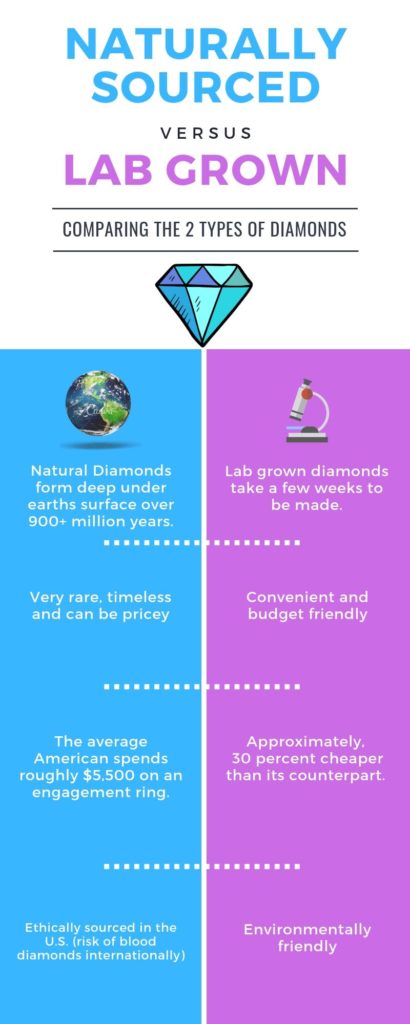Lab Grown Diamonds for Beginners
Table of ContentsWhat Does Lab Grown Diamonds Do?The Of Lab Grown DiamondsGet This Report about Lab Grown DiamondsThe Only Guide to Lab Grown Diamonds
As you travel closer to the Planet's core, stress and temperature rise, which produces the ideal oven for carbon to be converted into ruby (rubies are the only gemstone to be made from simply one aspect). Via a large volcanic eruption, these rubies were carried to the Earth's surface. It's approximated this procedure was rather fast (more than likely throughout several hours), which allowed the diamonds to remain intact without melting.The short answer: carat weights gauge the mass of rocks, karats gauge the purity of gold. Carat weight: 1 carat amounts to 0.2 grams, concerning the weight of a paperclip (next time you see a picture of Mariah Carey's 35 carat weight engagement ring, simply imagine the worry of carrying 35 paper clips around your finger each day).

Right here are some of the key benefits of lab expanded rubies and laboratory grown up diamond jewelry:.
Lab Grown Diamonds - The Facts
Put merely, all-natural or earth-mined rubies are crafted over countless years below the Planet's crust from pure carbon integrated with pressure and warmth. Creating rubies in a laboratory needs the same process, simply fine-tuned to occur over a much smaller amount of time in a far more controlled setup.
Whereas earth-mined rubies are uncommon and finite and have a tendency to boost in cost over time, lab rubies are readily available., like lab-grown diamond rings, they won't be an excellent fit for your needs.
They may think that the cons of lab-grown rubies surpass the pros. Some may argue that, for this reason, buying a lab-made diamond also comes with its honest considerations, as doing so takes earnings away from those involved in the all-natural ruby industry who might need it most.
Conventional rubies depend on the Planet's conditions to establish their quality or absence thereof. However in a laboratory, manufacturers can straight manage a ruby's top quality. Yes, there are honest and environmental considerations with both extracted and man-made diamonds. Expect your budget just allows you to look for particular colors or cuts of natural diamonds.
Unknown Facts About Lab Grown Diamonds
You can conveniently discover tinted, manufactured rubies on the (relatively) low-cost side as well as particular cuts that would certainly be more expensive more info if you were going shopping for an extracted diamond just. That hardly suggests it isn't worth protecting.
all-natural rubies is that the latter is mined from all-natural down payments in the Earth while the previous is made in a laboratory using controlled settings. But their top quality is mostly the same. Lab Grown Diamonds. While the distinction between lab-grown and natural ruby options are marginal when it comes to high quality, some of the disadvantages of lab-grown diamonds include the reality that the rock will diminish with time and, to some, a lack of nostalgic value that's usually connected with extracted diamonds
The process entails very little land disruption and gets rid of worries connected to deforestation and environment devastation. Lab-grown diamonds are typically extra budget-friendly than natural diamonds. This price difference can be connected to the structured manufacturing procedure and the evasion of costs related to traditional mining. The Controlled Setting in Which Lab Grown Diamonds Are Produced Enables Consistent High Quality.
Versatility in Design - Lab Grown Diamonds Offer Developers and Customers a Versatile Scheme to Produce Special and Cutting-edge Precious Jewelry Styles - Lab Grown Diamonds. Lab Diamonds Usually Come with An Even More Clear Supply Chain.
The 5-Minute Rule for Lab Grown Diamonds
Market Understanding - In Spite Of Their Identical Physical Characteristics, Laboratory Diamonds Might Face Challenges in Market Assumption. Some Consumers Still Perceive Natural Diamonds as Having Greater Worth and Prestige. The Production of Lab-Grown Diamonds Can Be Energy-Intensive, Particularly in Methods Like High Pressure High Temperature level (hpht) and Chemical Vapor Deposition (cvd).
Natural Diamonds Are Created Over Millions of Years Deep Within the Earth, Adding to Their Regarded Rarity. Lab-Grown Diamonds, Despite Their Identical Residence, May Not Bring the Very Same Rarity Factor, Affecting Their Perceived Worth for Some Customers. Influence on Diamond-Dependent Economies - the Shift Towards Laboratory Grown Diamonds Might Have Economic Ramifications for Countries and Areas that Rely On The Ruby Mining Market.

Ans. Lab Rubies Are of Equal Quality to Natural Diamonds in Terms of Firmness, Radiance, and Quality. the Quality of A Diamond, Whether Lab-Grown or Mined, Is Identified by Its Cut, Color, Clarity, and Carat Weight Weight. Ans. Yes, Laboratory Diamonds Glimmer Just Like All-natural Diamonds. Their Sparkle and Sparkle Are a Result of Their Cut and The Means Light Connects with Their Elements. Ans.